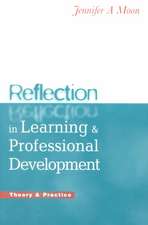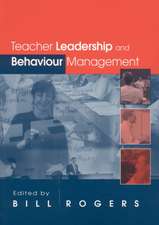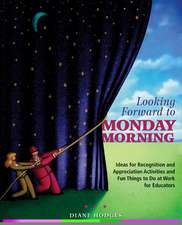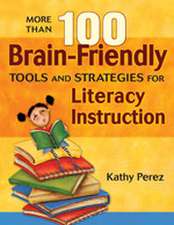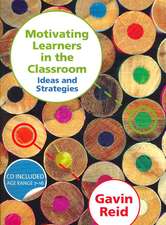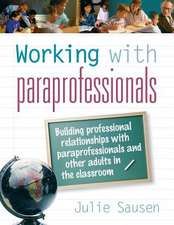The Evolution of Inquiry: Controlled, Guided, Modeled, and Free
Autor Daniel Callisonen Limba Engleză Paperback – 25 mai 2015 – vârsta până la 17 ani
Preț: 265.11 lei
Preț vechi: 380.38 lei
-30% Nou
Puncte Express: 398
Preț estimativ în valută:
50.73€ • 53.10$ • 42.22£
50.73€ • 53.10$ • 42.22£
Carte tipărită la comandă
Livrare economică 31 martie-14 aprilie
Preluare comenzi: 021 569.72.76
Specificații
ISBN-13: 9781610693868
ISBN-10: 1610693868
Pagini: 272
Dimensiuni: 216 x 279 x 20 mm
Greutate: 0.74 kg
Editura: Bloomsbury Publishing
Colecția Libraries Unlimited
Locul publicării:New York, United States
ISBN-10: 1610693868
Pagini: 272
Dimensiuni: 216 x 279 x 20 mm
Greutate: 0.74 kg
Editura: Bloomsbury Publishing
Colecția Libraries Unlimited
Locul publicării:New York, United States
Caracteristici
Illustrates the expectations for inquiry learning based on critical thinking and the ability to make a clear argument with supporting, relevant evidence selected on the basis of logical reasoning
Notă biografică
Daniel Callison, EdD, is professor emeritus in school media and instructional systems technology, and dean emeritus in online adult education and distance continuing studies at Indiana University, Bloomington, IN.
Cuprins
CONTENTSPrefaceAcknowledgmentsSECTION I: INQUIRY: CONTROLLED, GUIDED, MODELED, AND FREEChapter 1 : Key Artifacts Reflecting Progression and Evolution Toward Inquiry Chapter 2 : Evolution of Controlled Inquiry Chapter 3: Guided, Modeled, and Mentored Inquiry Enhanced by Cognitive Apprenticeship Chapter 4: Free Inquiry and Student-Centered Learning Chapter 5: Various Perceptions of Inquiry SECTION II: INFORMATION INQUIRY: LEARNING PRACTICES FROM SCHOOL LIBRARY MONTHLYBibliography of Inquiry Articles from School Library Monthly 1997û2014Callison, D. and A. Lamb. "Authentic Learning" Callison, D. "The Student Information Scientist, Part I" Callison, D. "The Student Information Scientist, Part 2" Lamb, A. and D. Callison. "Graphic Inquiry for All Learners" SECTION III: INFORMATION INQUIRY ACROSS THE CURRICULUM: ARTICLES FROM SCHOOL LIBRARY MONTHLYChapter 6: Inquiry in Science and MathChapter 7: Inquiry in Language ArtsChapter 8: Inquiry in History Chapter 9: Inquiry and the Argument Curriculum Chapter 10: Inquiry and CommunicationSECTION IV: ADDITIONAL RESEARCH REVIEWSChapter 11: Challenges & Opportunities for Collaboration, Expanded Roles, and Future Facilities Chapter 12: Research on Inquiry Learning and Teaching Techniques Chapter 13: Student Online Searching and Evaluating Information Chapter 14: A Timeline for the Progression Through Information Literacy to Inquiry Index
Recenzii
Overall, The Evolution of Inquiry is a labour of love showcasing a lifetime of work from an academic and teacher of teachers. In reading this you will gain an understanding of the relevance of inquiry to libraries and media literacy and see the importance of implementing inquiry-based learning in library programs so we can teach our students the important skill of 'how to think rather than what to think.' (p. 34)
We wish that other discipline experts would recognize the expertise that Daniel recounts in this book. Perhaps it will stand as evidence of our expertise alongside those outside our discipline who claim that area as their own. An important theoretical addition to the literature.
Overall, Callison presents the reader with a historical and comprehensive review of the various education and school library models integral to the concepts of inquiry. The work creates a strong argument for why school librarians can and should be involved in 'the scaffold building toward greater independent learning' (11). Drawing parallels to the author's statement that 'inquiry requires students to be active rather than passive learners' (57), the contents of The Evolution of Inquiry do not lead readers through a controlled story but represent an admirable lifetime of research, which can be interpreted and utilized by those willing to free their minds from the constraints of the library profession.
We wish that other discipline experts would recognize the expertise that Daniel recounts in this book. Perhaps it will stand as evidence of our expertise alongside those outside our discipline who claim that area as their own. An important theoretical addition to the literature.
Overall, Callison presents the reader with a historical and comprehensive review of the various education and school library models integral to the concepts of inquiry. The work creates a strong argument for why school librarians can and should be involved in 'the scaffold building toward greater independent learning' (11). Drawing parallels to the author's statement that 'inquiry requires students to be active rather than passive learners' (57), the contents of The Evolution of Inquiry do not lead readers through a controlled story but represent an admirable lifetime of research, which can be interpreted and utilized by those willing to free their minds from the constraints of the library profession.

